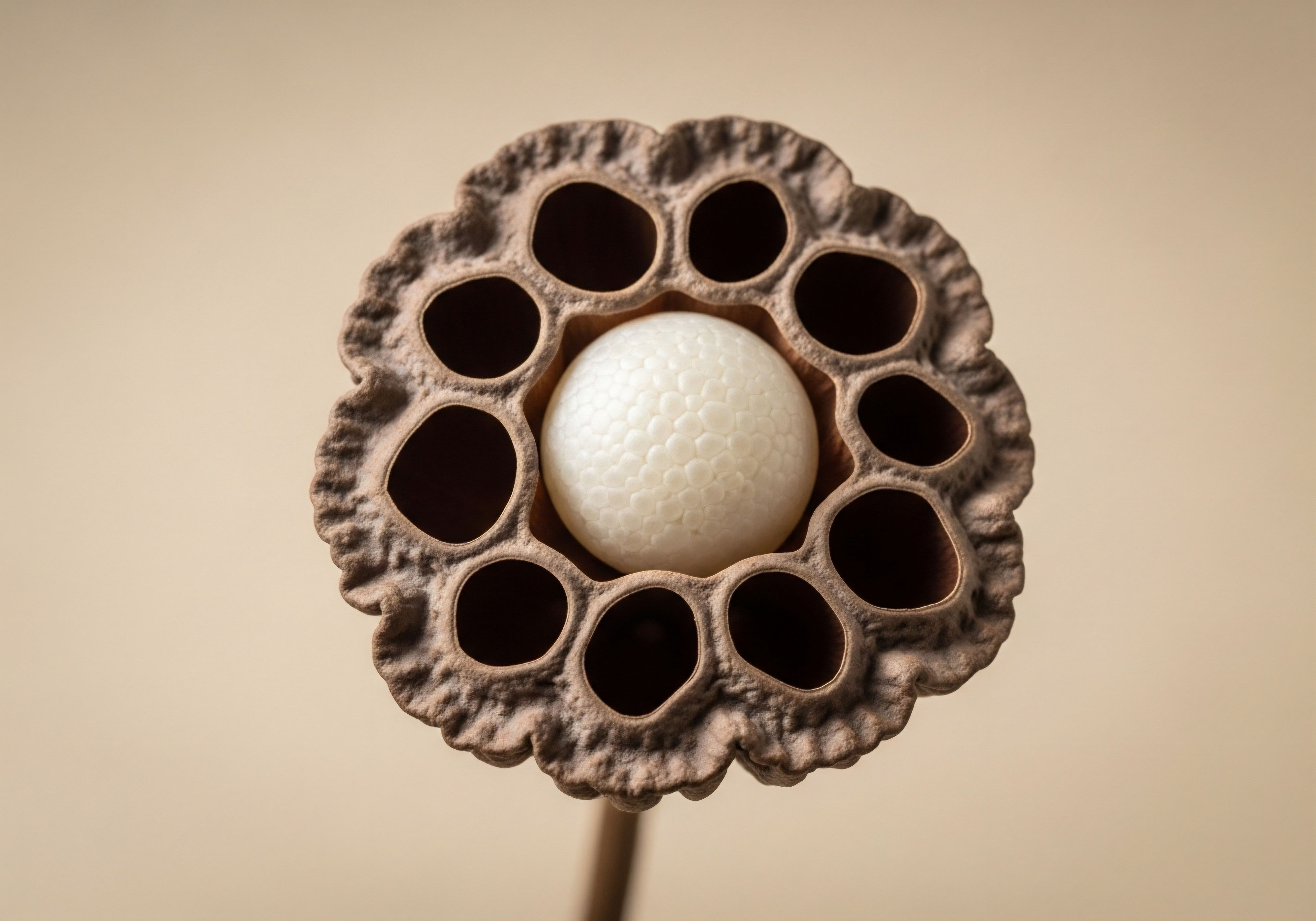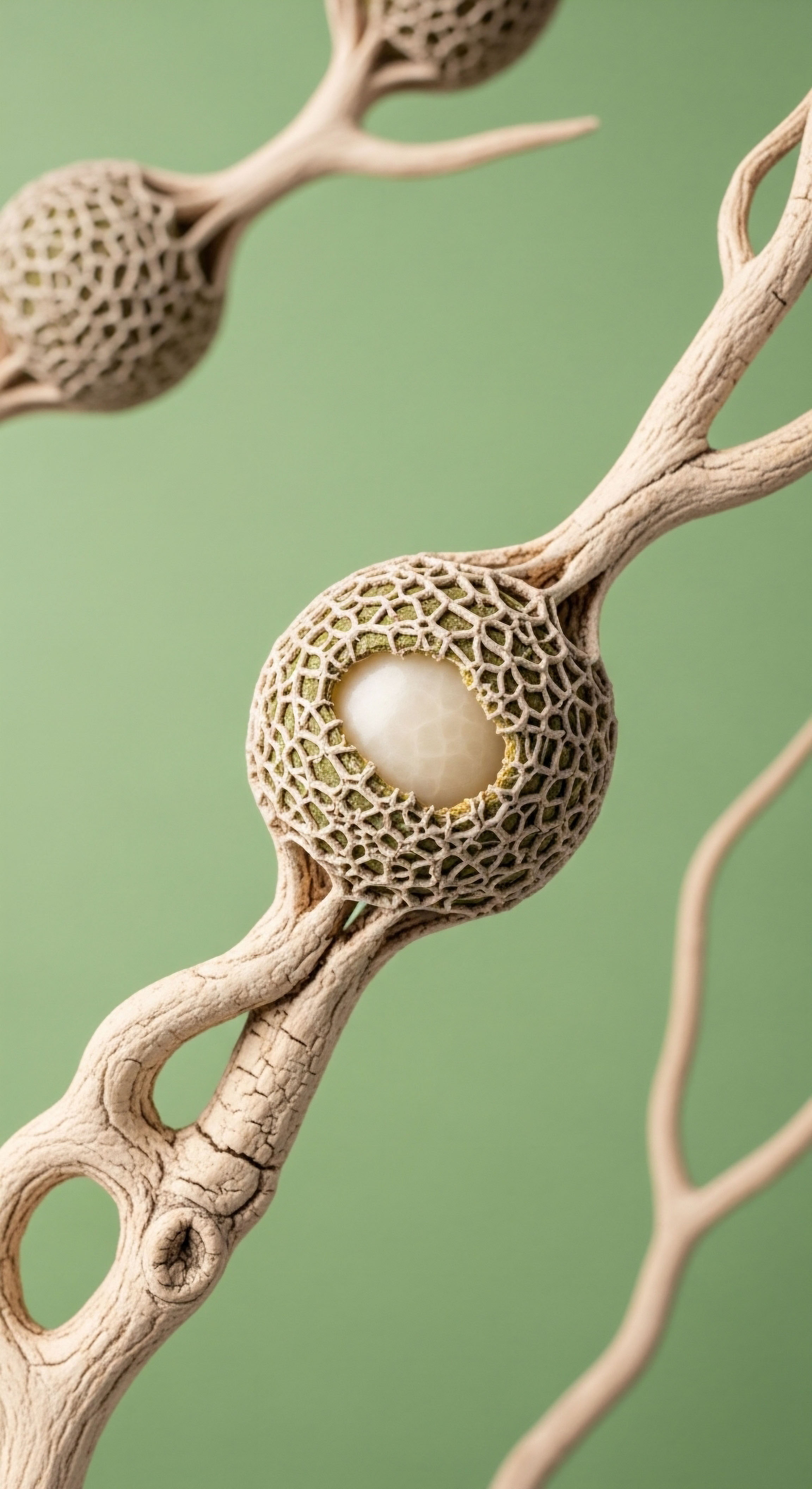

Fundamentals
Embarking on a protocol to optimize testosterone levels is a significant decision, one that often originates from a place of deep personal awareness. You may have noticed a subtle decline in energy, a shift in mood, or a general sense of diminished vitality. These experiences are valid data points.
They are your body’s method of communicating a change in its internal environment. When considering testosterone therapy, the conversation naturally includes its powerful benefits for restoring metabolic function, muscle mass, and overall well-being. A critical component of this conversation, however, involves understanding its profound impact on the reproductive system. The decision to begin hormonal optimization is a commitment to your own biological system, and that requires a full accounting of how each part of that system is connected.
At the heart of this issue is a sophisticated biological communication network known as the Hypothalamic-Pituitary-Gonadal (HPG) axis. Think of this as the body’s internal command center for reproductive health. The hypothalamus, a small region in the brain, releases Gonadotropin-Releasing Hormone (GnRH).
This hormone signals the pituitary gland, another key player in the brain, to produce two essential messenger hormones ∞ Luteinizing Hormone (LH) and Follicle-Stimulating Hormone (FSH). These hormones travel through the bloodstream to the testes. LH instructs the Leydig cells in the testes to produce testosterone, while FSH directs the Sertoli cells to begin the process of creating sperm, a process called spermatogenesis.
This entire system operates on a sensitive negative feedback loop. When the brain detects sufficient testosterone in the bloodstream, it reduces the production of GnRH, LH, and FSH to maintain a state of balance.
Introducing external testosterone silences the natural hormonal signals required for sperm production, leading to a state of temporary infertility.
When you introduce testosterone from an external source, such as through injections or gels, your brain perceives an abundance of this hormone. In response, it dutifully shuts down its own production signals. The release of GnRH slows, which in turn halts the pituitary’s output of LH and FSH.
Without the stimulating signals of LH and FSH, the testes receive no instructions to produce their own testosterone or to generate sperm. The Leydig and Sertoli cells become dormant. This leads to a significant reduction, and often a complete cessation, of sperm production.
This state, known as azoospermia (the absence of sperm in the ejaculate), is a direct and predictable consequence of testosterone therapy when administered without supportive measures. The testes may also decrease in size due to this lack of stimulation. It is a physiological response that underscores the interconnectedness of your endocrine system.

The Core Biological Conflict
The central issue is the difference between testosterone in the bloodstream (serum testosterone) and testosterone concentration inside the testes (intratesticular testosterone). Systemic hormone therapy effectively raises serum testosterone, alleviating the symptoms of hypogonadism like low energy and reduced libido.
Spermatogenesis, however, requires an exceptionally high concentration of testosterone inside the testes ∞ up to 100 times higher than what is found in the blood. When the HPG axis is suppressed by external testosterone, the testes’ own production of the hormone plummets, causing intratesticular testosterone levels to fall dramatically.
This internal deficit is what halts sperm production, even while your blood levels are optimized. Addressing fertility during testosterone therapy means resolving this conflict by finding a way to maintain high intratesticular testosterone levels while simultaneously managing systemic hormone levels. This requires a protocol that supports, rather than replaces, the body’s intricate hormonal signaling.


Intermediate
Understanding the fundamental suppression of the HPG axis opens the door to a more granular, solution-oriented discussion. For an individual on a hormonal optimization protocol who wishes to preserve fertility, the objective is precise ∞ to maintain testicular function in the presence of exogenous testosterone.
This is achieved by introducing specific ancillary medications that work around the suppressed feedback loop, directly stimulating the components of the reproductive axis that have been quieted by the therapy. These strategies are designed to keep the testes active, preserving both their size and their capacity for spermatogenesis. The two primary agents used for this purpose are Human Chorionic Gonadotropin (hCG) and Gonadorelin, each with a distinct mechanism of action.

Direct Testicular Stimulation with hCG
Human Chorionic Gonadotropin (hCG) is a hormone that closely resembles Luteinizing Hormone (LH) in its molecular structure and function. Because of this similarity, it can bind to and activate the LH receptors on the Leydig cells within the testes. This action effectively bypasses the suppressed HPG axis. While the brain has ceased sending its LH signal, hCG provides a substitute signal directly to the testes. This stimulation accomplishes two critical goals for fertility preservation:
- Maintains Intratesticular Testosterone ∞ By activating the Leydig cells, hCG prompts the testes to continue producing their own testosterone. This keeps intratesticular testosterone levels high, which is the essential condition for spermatogenesis to continue.
- Prevents Testicular Atrophy ∞ The constant stimulation from hCG keeps the testicular tissue active and functional, preventing the reduction in size that typically occurs when the natural LH signal is absent.
Clinical protocols often involve administering hCG via subcutaneous injections two to three times per week alongside the primary testosterone therapy. Studies have demonstrated that co-administering hCG with testosterone can successfully maintain sperm production in many men.

Restoring the Natural Pulse with Gonadorelin
Gonadorelin presents a different, yet equally strategic, approach. Gonadorelin is a synthetic version of Gonadotropin-Releasing Hormone (GnRH), the initial signaling hormone produced by the hypothalamus. Instead of bypassing the brain and pituitary like hCG does, Gonadorelin aims to reactivate the natural signaling cascade.
It is administered in a way that mimics the body’s own pulsatile release of GnRH. This synthetic GnRH prompts the pituitary gland to release its own LH and FSH. These naturally produced gonadotropins then travel to the testes to stimulate testosterone and sperm production. This approach keeps the entire HPG axis engaged, from the pituitary downward. It is often considered a gentler way to maintain the system’s function during therapy.
Protocols to preserve fertility during testosterone therapy use ancillary medications to either mimic natural hormonal signals or restart the body’s own production of them.

What Is the Role of Selective Estrogen Receptor Modulators?
A third category of medication, Selective Estrogen Receptor Modulators (SERMs) like Clomiphene Citrate or its more targeted isomer, Enclomiphene, offers another layer of intervention. These oral medications work at the level of the hypothalamus. They selectively block estrogen receptors in the brain.
Since estrogen also contributes to the negative feedback that suppresses the HPG axis, blocking its effects can “trick” the brain into thinking hormone levels are low. This perception prompts the hypothalamus to increase GnRH production, which in turn stimulates the pituitary to release more LH and FSH.
Enclomiphene is often favored because it has been shown to effectively raise testosterone and gonadotropin levels without some of the side effects associated with Clomiphene. SERMs can be used in conjunction with testosterone therapy or as a standalone therapy to boost the body’s own testosterone production while preserving fertility.
| Medication | Mechanism of Action | Effect on HPG Axis | Primary Use Case |
|---|---|---|---|
| hCG | Acts as an LH analog, directly stimulating Leydig cells in the testes. | Bypasses the suppressed hypothalamus and pituitary. | Co-administered with TRT to maintain intratesticular testosterone and prevent testicular atrophy. |
| Gonadorelin | Acts as a GnRH analog, stimulating the pituitary to release LH and FSH. | Reactivates the pituitary-gonadal portion of the axis. | Used with TRT to maintain the natural pulsatile release of gonadotropins. |
| Enclomiphene | Blocks estrogen receptors in the hypothalamus, increasing GnRH release. | Stimulates the entire HPG axis from the top down. | Used with TRT or as monotherapy to boost endogenous testosterone and sperm production. |


Academic
A sophisticated analysis of fertility preservation during androgen optimization requires moving beyond simple hormonal replacement and examining the intricate cellular and molecular dynamics within the seminiferous tubules. The decision to forego fertility-sparing protocols during testosterone therapy initiates a cascade of events that culminates in the profound disruption of spermatogenesis.
This process is governed by the absolute requirement for extremely high local concentrations of intratesticular testosterone, a condition that is obliterated by the negative feedback inhibition of the HPG axis induced by exogenous androgens. The failure to address this leads to a state of iatrogenic, or medically induced, secondary hypogonadism, where serum androgen levels are adequate for systemic health but testicular function is severely compromised.

The Cellular Machinery of Spermatogenesis Shutdown
Spermatogenesis is a complex, multi-stage process orchestrated by the Sertoli cells within the seminiferous tubules. These cells are the “nurses” of sperm production, providing structural support and nourishment to developing germ cells. Their function is critically dependent on two hormonal inputs ∞ FSH from the pituitary and high concentrations of testosterone produced by the adjacent Leydig cells. When exogenous testosterone therapy suppresses LH and FSH, the following sequence unfolds at a cellular level:
- LH Suppression and Leydig Cell Quiescence ∞ The absence of LH signaling causes the Leydig cells to cease production of testosterone. This leads to a precipitous drop in intratesticular testosterone concentrations, falling from levels that are 50-100 times that of serum to levels far below the threshold required for spermatogenesis.
- FSH Suppression and Sertoli Cell Dysfunction ∞ The concurrent suppression of FSH deprives the Sertoli cells of their primary stimulating signal. This impairs their ability to support germ cell development and maturation. Sertoli cells are responsible for maintaining the blood-testis barrier, a critical structure that isolates developing sperm from the immune system. Dysfunction in these cells can compromise this barrier.
- Arrest of Spermatid Development ∞ The lack of sufficient intratesticular testosterone causes a specific and critical failure point in the sperm production line. The transformation of round spermatids into elongated, motile spermatozoa is halted. This maturational arrest is a hallmark of androgen deprivation within the testes. The non-viable spermatids are often phagocytosed, or consumed, by the Sertoli cells.
This systematic dismantling of the spermatogenic process results in oligozoospermia (low sperm count) and can rapidly progress to azoospermia (complete absence of sperm). While this condition is reversible in most men after cessation of therapy, the timeline for recovery is highly variable and not guaranteed. Some individuals may experience prolonged or even permanent impairment of spermatogenesis.

How Do Ancillary Medications Restore Testicular Homeostasis?
The clinical strategies to counteract this are designed to restore the specific hormonal milieu required within the testes. The use of hCG is a direct intervention to compensate for the lack of endogenous LH. By providing an exogenous LH analog, it maintains Leydig cell steroidogenesis, ensuring that intratesticular testosterone remains at the supraphysiological levels necessary for sperm maturation.
The use of SERMs like Enclomiphene represents a more upstream intervention. By blocking estrogenic negative feedback at the hypothalamus, it preserves the endogenous pulsatile release of GnRH, thereby maintaining some level of native LH and FSH secretion. This can be sufficient to prevent the complete shutdown of the testicular machinery. The choice between these strategies depends on the individual’s specific goals, baseline hormonal status, and response to therapy.
The failure to preserve fertility during testosterone therapy results in a predictable shutdown of the intricate cellular machinery responsible for sperm production.
| Hormonal Parameter | TRT Monotherapy | TRT with hCG/SERMs |
|---|---|---|
| Serum Testosterone | Normal to High | Normal to High |
| Luteinizing Hormone (LH) | Suppressed/Undetectable | Maintained or Stimulated |
| Follicle-Stimulating Hormone (FSH) | Suppressed/Undetectable | Maintained or Stimulated |
| Intratesticular Testosterone | Severely Reduced | Maintained at High Levels |
| Spermatogenesis | Impaired or Ceased | Preserved |

References
- Lee, J. A. & Ramasamy, R. (2018). Indications for the use of human chorionic gonadotropic hormone for the management of infertility in hypogonadal men. Translational Andrology and Urology, 7(Suppl 1), S348 ∞ S352.
- Rastrelli, G. et al. (2019). Testosterone replacement therapy. In Endotext. MDText.com, Inc.
- Hsieh, T. C. et al. (2013). Concomitant intramuscular human chorionic gonadotropin preserves spermatogenesis in men undergoing testosterone replacement therapy. The Journal of Urology, 189(2), 647-650.
- La Vignera, S. et al. (2021). Suppression of Spermatogenesis by Exogenous Testosterone. Current Pharmaceutical Design, 27(24), 2750-2753.
- Patel, A. S. et al. (2019). The use of enclomiphene citrate in the treatment of secondary male hypogonadism. The World Journal of Men’s Health, 37(2), 241-246.
- Crosnoe-Shipley, L. E. et al. (2015). A new option for balancing fertility and testosterone therapy. Urology, 85(3), 597-601.
- Wheeler, K. M. et al. (2019). A review of the safety and efficacy of testosterone supplementation in the treatment of male hypogonadism. Sexual Medicine Reviews, 7(1), 78-90.
- Bhasin, S. et al. (2018). Testosterone therapy in men with hypogonadism ∞ an Endocrine Society clinical practice guideline. The Journal of Clinical Endocrinology & Metabolism, 103(5), 1715-1744.
- Krzastek, S. C. & Smith, R. P. (2020). The use of clomiphene citrate in the treatment of male infertility. Translational Andrology and Urology, 9(6), 2971 ∞ 2979.
- Masterson, T. A. et al. (2021). The effect of nasal testosterone gel on spermatogenesis ∞ a phase IV, open-label, single-arm study. Andrology, 9(4), 1174-1181.

Reflection
The information presented here provides a map of the biological territory you are considering navigating. It details the pathways, the control centers, and the consequences of specific actions within your body’s complex endocrine system. This knowledge is a powerful tool. It transforms the conversation from one of uncertainty to one of informed choice.
Your personal health narrative is unique, written in the language of your own physiology and experience. Understanding the risks of not addressing fertility during testosterone therapy is a foundational step. The next is to consider how this information applies to your individual circumstances, your long-term goals, and your vision for a life of sustained vitality. This journey is about recalibrating your system to function optimally, and every decision made with clarity and understanding moves you closer to that objective.



